Understanding Azure DevOps: A Beginner-to-Advanced Guide
- WeeklyTechReview

- Jan 15
- 4 min read
Updated: 5 days ago
In today’s fast-paced tech world, companies rely on efficient tools to develop, deploy, and manage software quickly. Azure DevOps is one such tool that brings development and operations teams together to streamline processes and deliver software faster and more reliably.
Whether you are new to DevOps or aiming for an advanced role, this guide will help you understand Azure DevOps from the ground up.
What is Azure DevOps?

Azure DevOps is a cloud-based service provided by Microsoft that supports DevOps practices. It integrates tools to help teams plan, develop, test, and deploy software collaboratively. Azure DevOps enables continuous integration and continuous delivery (CI/CD), ensuring smooth development and faster releases.
Components of Azure DevOps
Azure DevOps has five primary services that help manage the software development lifecycle:
1. Azure Boards
What it does: Azure Boards helps teams manage work items, track progress, and plan projects efficiently.
Key Features:
Kanban Boards: Visualize and manage tasks easily.
Scrum Support: Agile project management tools.
Work Item Tracking: Track bugs, tasks, and user stories.
Example: Imagine you’re building an app. You can create tasks like “Design Login Screen” and “Develop Authentication API” and assign them to team members with due dates.
2. Azure Repos
What it does: Azure Repos is a version control system to manage your code.
Key Features:
Git Repositories: Store your code in Git for better collaboration.
Branching: Work on features separately and merge them later.
Pull Requests: Review code changes before integrating them.
Example: You and your team can work on different parts of the app’s code and merge your changes into the main project without overwriting each other’s work.
3. Azure Pipelines
What it does: Azure Pipelines automates the process of building, testing, and deploying your application.
Key Features:
Continuous Integration (CI): Automatically build and test your code after every change.
Continuous Delivery (CD): Deploy your application to different environments (e.g., testing, staging, production).
Multi-platform Support: Works with any programming language and platform.
Example: When a developer updates the login feature, Azure Pipelines can automatically build the new code, test it for errors, and deploy it to a testing environment.
4. Azure Test Plans
What it does: Azure Test Plans helps you test your application to ensure quality.
Key Features:
Manual Testing: Perform step-by-step tests manually.
Automated Testing: Integrate automated tests into CI/CD pipelines.
Bug Tracking: Easily log and track bugs.
Example: You can run a test to check if the login feature is working as expected and automatically create a bug report if it fails.
5. Azure Artifacts
What it does: Azure Artifacts helps you manage and share packages (e.g., libraries, tools) used in your application.
Key Features:
Package Management: Store and distribute reusable code packages.
Integration: Works with popular package managers like NuGet, npm, and Maven.
Example: If you have a library for common UI elements, you can store it in Azure Artifacts and share it across multiple projects.
A Simple DevOps Project Using Azure DevOps
Let’s create a basic project to understand how Azure DevOps works in practice.
Scenario:
You want to create a website where users can register and log in. Here’s how Azure DevOps helps:
Plan the Project:
Use Azure Boards to create tasks like “Design User Interface” and “Develop Backend API”.
Assign these tasks to your team members.
Store Your Code:
Use Azure Repos to create a Git repository and store your code.
Team members can work on different branches, like one for the frontend and another for the backend.
Automate Builds and Tests:
Set up a CI pipeline in Azure Pipelines to build your code automatically after every change.
Add unit tests to ensure the new code doesn’t break existing functionality.
Deploy Your Application:
Use Azure Pipelines for CD to deploy the website to a testing environment after it passes all tests.
Test the Application:
Use Azure Test Plans to run manual and automated tests to verify that the registration and login features work correctly.
Log any issues found and assign them to the respective developers.
Manage Dependencies:
Use Azure Artifacts to store shared libraries or tools required for your website.
Why Use Azure DevOps?
Azure DevOps is:
Collaborative: Brings developers, testers, and operations teams together.
Flexible: Works with various tools and platforms.
Scalable: Suitable for small teams or large enterprises.
Efficient: Automates repetitive tasks, saving time and effort.
Advanced Features of Azure DevOps
For those looking to go beyond the basics, Azure DevOps offers:
Integration with Azure Cloud: Use Azure’s cloud services to host your applications.
Monitoring and Analytics: Track the performance of your applications.
Security and Compliance: Ensure your processes meet industry standards.
Custom Extensions: Add custom features to Azure DevOps.
Conclusion
Azure DevOps is a powerful tool for anyone involved in software development. Whether you are a beginner or an experienced professional, it provides everything you need to plan, build, test, and deploy software efficiently. Start with a simple project, explore its components, and gradually move to advanced features to make the most of Azure DevOps in your DevOps journey.










Comments